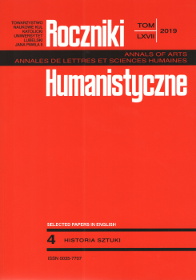What the Polish Mother Does Not Say. Zbylut Grzywacz Against the Myth
What the Polish Mother Does Not Say. Zbylut Grzywacz Against the Myth
Author(s): Dorota KudelskaSubject(s): Fine Arts / Performing Arts, Visual Arts, History of Art
Published by: Towarzystwo Naukowe KUL & Katolicki Uniwersytet Lubelski Jana Pawła II
Keywords: Zbylut Grzywacz; woman; Polish Mother—deconstruction of the myth; brutalization of the body form; Holbein; Rembrandt; communist Poland iconography
Summary/Abstract: The Polish version of the article was published in Roczniki Humanistyczne vol. 62, issue 4 (2014). The article presents the art of Zbylut Grzywacz in the context of his post-mortem exhibition in the Kraków National Museum in 2009. The subjects of the analysis are his paintings from the 1970s and 1980s, presenting women through a simple rough treatment of human body form, without an academic idealization. The destruction of the form conforms to the deconstruction of the myth of a Polish Mother. It is due to the change of a social position of the figures whom Grzywacz gives the roles of guardians of tradition, as well as due to their mental and moral degradation. The artist uses an irony in showing his knowledge of the tradition of showing a human body in an academic nude (what he denies), in a Flemish art of showing torn animal meat (with the Rembrandt’s reflection) and Holbein’s tradition of the post-mortem decay (The Body of the Dead Christ in the Tomb). One of the main themes in Grzywacz’s paintings is the loneliness, especially distinct in a representation of symbolically naked persons among insensible pedestrians. The Polish Mother—here she doesn’t belong to any society.The explicitness and the picturesque materiality covers a certain “crack” in the world presented inside the hard-to-comprehend present-day multitude of Grzywacz’s paintings. Behind the cover of the foreground tale, as one could think on the basis of the sketchbooks, there is a kind of an “unpresented world”, in which the author incessantly tells us about the pain of his existence with no anaesthetization by grotesque.
Journal: Roczniki Humanistyczne
- Issue Year: 67/2019
- Issue No: 4SP
- Page Range: 103-123
- Page Count: 21
- Language: English

